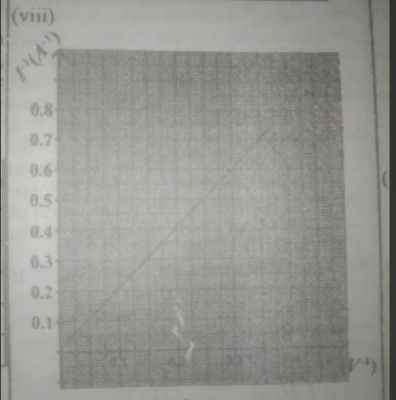ALTERNATIVE B
(a) You are provided with a variable DC power supply E, a key, an ammeter, a voltmeter and other necessary materials
(i) Set up a circuit as shown in the diagram above with E = 3.0V
(ii) Close the key.
(iii) Record the voltmeter reading, V
(iv) Read the corresponding ammeter reading, I
(v) Evaluate V\(^{-1}\) and I\(^{-1}\)
(vi) Repeat the procedure for the four other values of E = 4.5V, 6.0V, 7.5V and 9.0V.
(vii) Tabulate your readings.
(viii) Plot a graph with I\(^{-1}\) on the vertical axis and V\(^{-1}\) on the horizontal axis starting with both axes from the origin. (0, 0)
(ix) Determine the slope, s of the graph.
(x) Also, determine the intercept, c on the vertical axis
(xi) What does the slope, s represent?
(xii) State two precautions taken to ensure accurate results.
(b) State two methods by which an electric current can be produced
(i) State Ohm's law.

(vii)
| E(V) | V(V) | I(A) | V\(^{-1}\)(V\(^{-1}\)) |
I\(^{-1}\)(I\(^{-1}\)) |
| 3.00 | 2.86 | 1.43 | 0.350 | 0.699 |
| 4.50 | 4.28 | 2.14 | 0.234 | 0.467 |
| 6.00 | 5.70 | 2.86 | 0.175 | 0.350 |
| 7.50 | 7.14 | 3.57 | 0.140 | 0.280 |
| 9.00 | 8.57 | 4.28 | 0.117 | 0.234 |
(viii) SEE THE GRAPH ABOVE
(ix) Slope = \(\frac{Δ I^{-1}}{Δ V^{-1}}\) = \(\frac{0.6 - 0.3}{0.3 - 0.15}\) = \(\frac{0.3}{0.15}\) = 2
(x) Intercept, c = 0.01
(xi) Slope, s represents external resistance of the circuit
(xii) I. I ensured tight connections II. I avoided error due to parallax on the ammeter/voltmeter
b(i) I. Use of cell II. hydropower
(ii) Ohm's law states that the current passing through a metallic conductor is directly proportional to the potential difference applied at both ends provided temperature remains constant.
Contributions ({{ comment_count }})
Please wait...
Modal title
Report
Block User
{{ feedback_modal_data.title }}